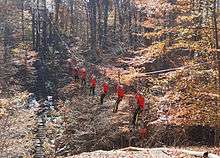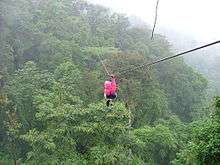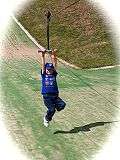Zip line
A zip line (or zip-line, zipline, zip wire, or aerial runway[1][2][3][4][5] consists of a pulley suspended on a cable, usually made of stainless steel, mounted on a slope. It is designed to enable cargo or a person propelled by gravity to travel from the top to the bottom of the inclined cable by holding on to or being attached to the freely moving pulley. It has been described as essentially a Tyrolean traverse that engages gravity to assist its speed of movement.[5] Its use is not confined to adventure sport, recreation, or tourism, but modern-day usage tends to favour these meanings.[6]


History
Ropeways or aerial cables have been used as a method of transport in some mountainous countries for more than 2,000 years, possibly starting in China, India and Japan as early as 250 BC,[7] remaining in use in some remote areas in China such as Nujiang (Salween) valley in Yunnan as late as 2015 before being replaced by bridges.[8] Not all of these structures were assisted by gravity, so not all fitted the definition of the zip-line.[7]
Various technological advances in Europe in the Middle Ages improved the ropeways, some of which were still assisted by gravity.[7]
The first recorded use of the zip-line as a form of entertainment was possibly in 1739, when Robert Cadman, a steeplejack and ropeslider, died when descending from Shrewsbury's St Mary's Church when his rope snapped. In literature, one appears in The Invisible Man[9] (published 1897) by H. G. Wells as part of a Whit Monday fair and referred to as "an inclined strong".[10]
Some sources attribute the development of zip-lines used today as a vacation activity to the Tyrolean traverses developed for mountaineering purposes.[5]
In the Australian outback, zip-lines were sometimes used for delivering necessities to people working in or on the other side of a valley, and they may have been used in conflicts by Australian troops to deliver food, mail and even ammunition to forward positions.[10][5][11]
Current uses
As a means of transport
Yungas, Bolivia, features a system of zip-lines used for transporting harvested crops, mainly coca, across a valley 200 m below.[12][13] They can also be seen in the Ladakh region of India.
In recent years, there has been renewed interest in the use of aerial ropeways for transporting cargo, partly due to their low energy requirements and environmental impact. Gravity-fed types, i.e. zip-lines, have been built in Nepal,[14] Latin America and India.[7]
Recreation
Children's adventure playgrounds
Zip-lines may be designed for children's play and found on some adventure playgrounds. Inclines are fairly shallow and so the speeds kept relatively low, negating the need for a means of stopping.[10] The term "flying fox" is commonly used in reference to such a small-scale zip-line in Australia and New Zealand.[15][16] With playground equipment, the pulleys are fixed to the cable, the user typically hanging onto a hand grip underneath but occasionally including a seat or a safety strap. Return of the grip or seat is usually done by simply pushing or pulling via a short wire it back to the top of the hill on foot.
Canopy tours and adventure zip-lining

Longer and higher rides are often used as a means of accessing remote areas, such as a rainforest canopy. In the 1970s, wildlife biologists set up zip-lines as a way to study and explore the dense rainforests of Costa Rica without disturbing the environment. The business idea for zip-line canopy tours developed from these. Darren Hreniuk, a Canadian citizen who moved to Costa Rica in 1992, around the same time that a scene in the film Medicine Man incorporated the treetop rides, with the goal of using canopy tours to help raise awareness for reforestation, education and socio-economic development in the surrounding areas.[5] In October 1998, the Costa Rican Patent Office granted patent No. 2532 for an "Elevated Forest Transport System Propelled by Gravity, Using Harness and Pulley Through a Simple Horizontal Line" to Hreniuk. The patent was later annulled and brought uncertainty to zip-line businesses, before being reinstated after 20 years.[17][18]
A canopy tour (sometimes called a zip-line tour) provides a route through a wooded and often mountainous landscape making primary use of zip-lines and aerial bridges between platforms built in trees. Tourists are harnessed to a cable for safety, and many are restricted to adults. Heights vary from a close to the ground to high up near the treetops.[19] Canopy tours are largely marketed under the banner of ecotourism, although the environmental impact of any type of zip-line is a disputed topic.[20]
The terminology varies (canopy tour, zip-lining, flying fox) and the line between using zip-lines for ecotourism and zip-lining as an adventure sport is often not clearly drawn.[21] Zip-line tours are now popular vacation activities, found at both upscale resorts and outdoor adventure camps, where they may be an element on a larger challenge such as a hike or ropes course.[22][23]
Operation
Mechanism

A type of pulley with a grooved wheel known as a sheave is used in zip-lines, and the pulley turns as it travels along, thus reducing friction and enabling greater speed than would otherwise be possible.[24]
The zip-line trolley is the frame or assembly together with the pulley inside that run along the cable.[25] Zip-lines also have some kind of device to allow the cargo or rider take advantage of the pulley system. This could include a harness, seat, a cabin or often just a handhold in smaller playground applications, that attaches to the pulley by a pivoting link or carabiner which secures the load, allowing the person or cargo to travel down the line.
Braking

To be propelled by gravity, the cable needs to be on a fairly steep slope. Even then the rider or cargo will often not travel completely to the end (although this will depend on the load), and some means of safely stopping the car at the bottom end is usually needed with the larger zip-lines. Users of zip-lines must have means of stopping themselves.[24] Typical mechanisms include:[26]
- Friction created between the pulley against the cable.
- Thick, purpose-built leather gloves.
- A mat or netting at the lower end of the incline.
- A passive arrester system composed of springs, pulleys, counterweights, bungee cord, tire or other devices, which slows and then stops the trolley's motion.
- A "capture block" which is a block on the cable tethered to a rope controlled by a person who can manually apply friction on the rope to slow the user down.
- Gravity stop, exploiting the sag in the cable, where the belly of the cable is always lower than the termination point. The amount of incline on a zip-line controls the speed at which the user arrives at the termination point.
- Hand brake at the end of the zip-line.
Safety
Professional versions of zip-lines used as an outdoor adventure activity are usually operated at high speeds, covering long distances and sometimes at considerable heights. Cables can be very high, starting at a height of over 9 m (30 ft), and traveling well over 460 m (1,510 ft). Riders are physically attached to the cable by a harness that attaches to a removable trolley. A helmet is required on almost all courses of any size. All zip-line cables have some degree of sag, so the proper tensioning of a cable is important and allows tuning the ride of a zip-line.
Regulation of the zip-lining industry throughout the world has come under scrutiny in the wake of a number of accidents around the world, and since the industry has been expanding so rapidly (in 2012 there were an estimated 200 commercial zip-lines in the US and a further 13,000 private ones; in the five years up to 2017, hundreds of zip-line businesses opened in the US alone).[27]
There is no official record of zip-lining fatalities, but there were more than a dozen news reports of deaths in the US between 2006 and 2017.[27] A 2015 study by The Research Institute at Nationwide Children's Hospital reported in the American Journal of Emergency Medicine found that the number of visits to the emergency room for zip-line injuries in the US increased from a few hundred per year in 1997 to more than 3,600 in 2012, with the total number of injuries estimated at 16,850. Researchers at Ohio State University also found that almost 12% of injuries resulted in fractures or other injuries requiring hospitalization.[28][29][27]
In the US there are three regulatory bodies, but they act in an advisory capacity only; according to Shawn Tierney, director of the Association for Challenge Course Technology (ACCT), there's a "kind of a patchwork of regulation that varies from state to state".[27] While many large-scale operations in the United States are standardized and regulated, smaller operations and operations outside the US are often only self-regulated.[30]
The ACCT published the first safety standards in March 1994. Experience Based Learning assisted in co-founding the second industry safety association, The Professional Ropes Course Association (PRCA)[31] in 2003. The PRCA was a more industry focused association with less vendor dominance. The Professional Ropes Course Association gained ANSI Accredited Standards Developer status on December 3, 2005. ACCT gained ANSI Accredited Standards Developer status in 2006. The PRCA published the first ANSI designated ANSI/PRCA American National Safety Standard in March 2014. The ACCT published an ANSI designation ANSI/ACCT American National Standard in 2016.
Records
Longest
The world's longest zip-line as of 31 January 2018 is the 'Jebel Jais Flight' from one of the peaks of the Jebel Jais mountain in Ras Al Khaimah, United Arab Emirates, with a single unbroken span of 2,831.88 m (9,290 ft 11 in).[32][33] However, the ride has been closed pending the outcome into an investigation into the crash of an Agusta 139 rescue helicopter on 29 December 2018, killing all on board, thought to have clipped one of the cables.[34]
The "Parque de Aventura Barrancas del Cobre" at 2545 m (8,350 ft) in Copper Canyon, Mexico, was bumped to second place,[35] with "El Monstruo" at Orocovis in Puerto Rico coming in third, at 2530 m (8,300 ft).[36]
The longest zip-line in England is the Skywire[37] at the Eden Project in Cornwall measuring 660 meters (2,165 ft). The longest zip-line in Europe, at just over 1600 meters long, is the Zip World Bethesda line in Penrhyn Quarry, Bethesda, Wales. The Zip World Bethesda line also holds the record for being the fastest Zip-Line in the world.[38][39]
Steepest
There is currently no official Guinness World Record for the world's steepest zip-line, so certainty is difficult to establish, but some contenders have been:
- Saint Martin's Rockland Estate Rainforest Adventures zip-line (opened 24 November 2017), dropping 320 m (1,050 ft) across the 853 m (2,800 ft) of cable.[40]
- At Letalnica bratov Gorišek, on the ski flying hill in Planica, Slovenia (opened 19 September 2015). It is 566 metres (1,857 ft) long with a 202 metres (663 ft) vertical drop. It has an average 38.33% and a maximum 58.6% incline.[41]
- ZipFlyer in Nepal (run by HighGround Adventures – 2012) with a maximum incline of 56% (and still claiming to be the world's tallest zip-line). It had a vertical drop of 610 m (2,000 ft).[42][43]
Oldest person to ride a zip-line
- British great-grandfather Jack Reynolds became the oldest person to ride a zip-line on his 106th birthday on 6 April 2018 at Go Ape in Grizedale Forest, Cumbria.[44]
See also
References
- Who Really Benefits from Tourism, Publ. Equations, Karnataka, India, 2010. Working Papers Series. "Canopy Tourism", page 37
- Jacques Marais, Lisa De Speville, Adventure Racing, Publisher Human Kinetics, 2004, ISBN 0736059113, 9780736059114, 160 pages, page 156
- "Equitable Tourism Options (EQUATIONS) – Working Paper Series 2009-10". equitabletourism.org. Retrieved 1 May 2018.
- "Foefie slide definition and meaning – Collins English Dictionary". www.collinsdictionary.com. Retrieved 1 May 2018.
- Outdoor Fun Store. "History of The Zipline". Archived from the original on 25 February 2012. Retrieved 22 January 2019.CS1 maint: unfit url (link)
- Based on Google search of the term.
- "Aerial ropeways: automatic cargo transport for a bargain". LOW-TECH MAGAZINE, Doubts on progress and technology. Retrieved 28 August 2014.
- "Bye-bye Nujiang ziplines". GoKunming. Retrieved 2 December 2015.
- See the second paragraph here where the phrase is underlined.
- "All about Zip Lines". Zipline Consultant. 2018. Archived from the original on 18 August 2018. Retrieved 21 January 2019.
- Although these claims are repeated on several sites, an original reliable source of the information has not been found.
- "The flying men of Yungas Valley". www.aljazeera.com. Retrieved 1 May 2018.
- Al Jazeera. "Cocaleros in Bolivia do not walk – they fly". documentary.net. Retrieved 25 January 2019.
- "Aerial Ropeways in Nepal". No Tech Magazine. 12 October 2009. Archived from the original on 4 December 2017. Retrieved 22 January 2019.
- "Zip-Lines, Flying Fox in Australia". Ziplinerider.com. Retrieved 9 August 2012.
- "Zip-Lines, Flying Fox in New Zealand". Ziplinerider.com. Archived from the original on 6 June 2012. Retrieved 9 August 2012.
- Abogados, CastroPal (10 November 2018). "Costa Rica – patent leaves canopy tours dangling". Archived from the original on 22 January 2019. Retrieved 22 January 2019.
- Anders, Wendy (1 June 2017). "Canopy Patent Reinstated to Canadian Man in Costa Rica After 20 Year Legal Battle". Costa Rica Star. Retrieved 22 January 2019.
- Friedland, Lois (22 November 2017). "Take a Zipline or Canopy Tour". Tripsavvy. Archived from the original on 1 July 2018. Retrieved 23 January 2019.
- Kershner, Kate. "How zip lines work: History of zip lines". howstuffworks. Archived from the original on 29 June 2018. Retrieved 23 January 2019.
- "Zipline locations". Zipline Rider. Archived from the original on 23 January 2019. Retrieved 24 January 2019.; also a number of commercial sites such as Adrenaline: Flying fox & tree adventures, Adventure America: Zipline canopy tours
- Thayer, Matthew (September–October 2008). "Don't Look Down!". Maui No Ka ‘Oi magazine. Maui, Hawaii. Archived from the original on 26 November 2010. Retrieved 9 March 2011.
- Friedland, Lois (25 May 2018). "The most extreme ziplines in America". Archived from the original on 24 January 2019. Retrieved 24 January 2019.
- Kershner, Kate. "How zip lines work: Physics of zip lines". howstuffworks. Archived from the original on 29 June 2018. Retrieved 23 January 2019.
- Some examples can be seen here.
- Roper, Aaron. "Zip Line Braking Methods". ZipLineGear Knowledge Base. Retrieved 2 February 2015.
- Borell, Brendan (28 February 2017). "Just how dangerous are zip lines?". Outside. Archived from the original on 13 March 2017. Retrieved 24 January 2019.
- "Zipline-related injuries are rapidly increasing". Science Daily. 5 October 2015. Retrieved 7 October 2015.
- Billock, Rachael M.; Anderegg, Jonathan J. (December 2015). "Zipline-related injuries treated in US EDs, 1997–2012". 33 (12). American Journal of Emergency Medicine: 1745–1749. Retrieved 24 January 2019. Cite journal requires
|journal=(help) - Kershner, Kate. "How zip lines work: Zip-line accidents". howstuffworks. Archived from the original on 22 July 2017. Retrieved 24 January 2019.
- http://www.prcainfo.org/
- Lockwood, Rosanna. "UAE claims world's longest zipline". reuters.com. Retrieved 1 May 2018.
- "Longest zip-wire". Guinness World Records. 31 January 2018. Archived from the original on 25 January 2019. Retrieved 25 January 2019.
- "UAE helicopter crash kills four crew on rescue mission near zipline". BBC News. 30 December 2018. Archived from the original on 2 January 2019. Retrieved 25 January 2019.
- "Copper Canyon, Mexico Ziprider". Ziprider.com. Archived from the original on 29 December 2015. Retrieved 29 December 2015., http://parktropa.com/our-works-en/zipline/
- Abney, Clay (10 May 2018). "Take flight on the 3 longest zip-lines in the world". The Manual. Archived from the original on 25 January 2019. Retrieved 25 January 2019.
- "One of the best things to do in Cornwall | SkyWire Zip Wire". hanglooseadventure.com. Retrieved 15 June 2018.
- "The 100 MPH slide; Riding Europe's Longest Zipline". Retrieved 3 July 2016.
- "Zip World Velocity". Archived from the original on 15 August 2016. Retrieved 3 July 2016.
- Rizzo, Cailey (11 December 2017). "The world's steepest zip line offers breathtaking views over St. Martin". Smithsonian.com. Archived from the original on 29 January 2018. Retrieved 25 January 2019.
- "Become hero of Planica". Retrieved 18 September 2015.
- "HGnepal Website". Archived from the original on 9 July 2012. Retrieved 4 July 2012.
- "Longest Zip Lines". ziplinerider.com. Archived from the original on 30 April 2012. Retrieved 17 April 2012.
- Swatman, Rachel (18 September 2018). "106-year-old sets birthday zip wire record – after getting tattoo and riding rollercoaster". Guinness World Records. Archived from the original on 28 January 2019. Retrieved 28 January 2019.
| Wikimedia Commons has media related to Zip lines. |
| Wikivoyage has a travel guide for Ziplining. |
| Look up flying fox in Wiktionary, the free dictionary. |

